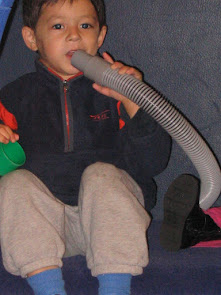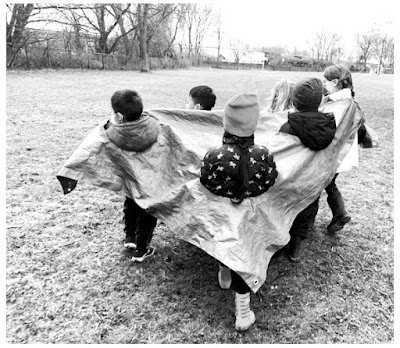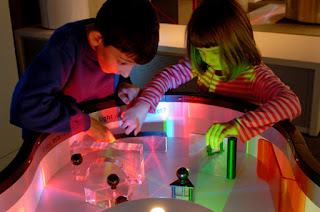MUSEUM NOTES
Jeanne Vergeront
Vergeront Museum Planning
Play Conditions are a bit like Robinsyard. Robinsyard, you ask?
When my nephew Matthew was 4 years old, he carried a small rolled up piece of paper tucked into a yarn belt that he liked to wear. I asked him what had he drawn on the paper and he replied, “Robinsyard.” I knew he had a friend name Robin, but I didn’t know what a Syard was. So, I asked, “What’s a Syard?” Matthew replied, “I don’t know but Robin has one.” After some mulling about what a Syard might be, I guessed that it was Robin’s Yard. The precise meaning is not so critical. What is important is that:
Play conditions are like Robinsyard: It’s hard to explain what they are, but we have them. And play conditions have meaning in children’s lives.
We may not have precise terms for play conditions, a shared vocabulary, or a taxonomy for them. (We don’t really have a definition of play, either.) We do, however, have a sense of when play conditions are just right: when children are engaged actively, deeply, and joyously in play—play that they direct and find enjoyable. That’s when play conditions are well tuned. Conversely, when interactions are few, focus and attention is brief, conflict is frequent, children’s affect is flat, and ambience is bland, play conditions are out-of-whack with the intentions for the experience, the space, and those children.
Play doesn’t happen independently of the conditions surrounding it. Since we think, in general, very little about the conditions that encourage exploring, playing, and learning, we are hazy about just what they are and how to harness them. For about the last 10 years, I’ve been exploring the idea of play conditions in planning work, learning frameworks, and master plans. Currently, I am part of a team at WonderTrek Children’s Museum, an emerging museum in north central Minnesota, working with play conditions in a collaborative question-driven, iterative process that explores, documents, and shares insights from children in play-based settings.
This work is giving shape to a framework that helps get at the complexity and simplicity of
play and play conditions. Starting with working definitions, this framework acknowledges related concepts, identifies a set of play conditions, and frames principles that tell us something about the nature of these play conditions.
 |
Photocredit: Vergeront (MIA) |
While the framework focuses on play conditions, it is relevant to shaping spaces and experiences in every kind of museum as well as encouraging inquiry and learning. In fact, museum planners, developers, designers, and educators often draw on qualities and varied conditions in creating exhibits, environments, and programs that engage visitors— but they may not be doing so intentionally nor focusing on play.
Play and Play Conditions
Exploring play conditions relies on having a shared understanding of play among staff, team, or partners. This can be challenging. Affected by age, setting, and who’s controlling it, play is not always easy to recognize. It is connected to exploration and learning which children seem to move between seamlessly. Definitions of play are abundant as well. One I am drawn to places the child at the center and works across varied contexts. Play is freely chosen, personally directed, and intrinsically motivated.
Viewing play conditions as the qualities or variables of the physical and social environments that are likely to encourage (or discourage) and support children’s play accommodates this definition of play and others. It also recognizes that there can be conditions that interfere with play.
 |
| Photo credit: Vergeront (CMOM) |
While play conditions may include affordances, they are not limited to physical features nor are they directive. More than 3-dimensional space, physical design, furniture, or arrangement, play condition’s qualities are also temporal, social, and affective. They tap into all senses, give cues, and suggest possibilities. Neither a recipe nor a formula, nor a way of scripting children’s play, play conditions are as open-ended as play itself.
Seven Play Conditions
An understanding of play conditions emerges from what research, child development, play theory and museum practices suggest will encourage and support children’s exploration, play, and learning in informal learning settings. Dimensions such as space, materials, relationships, and provocations, salient to different aspects of play, help in understanding play conditions. Observations, imagination, and intuition add to this knowledge, filling gaps and inviting us to think together.
By separating and clustering these dimensions, we discover examples and possibilities, and begin to examine and manipulate play conditions in intentional and new ways. Seven play conditions are summarized below. Each is characterized by the general role it plays, its valued qualities, and a small sample of possibilities.
- Image of the Child is about the child’s strengths and capabilities and means engaging children at their highest level of ability; and making their strengths and capabilities visible.
- Valued qualities are: children’s curiosity, capabilities, social disposition, caring and empathy
- Possibilities that support and reflect the child’s capabilities: choices for one child and different choices for different children; traces of children’s thinking, doing, and making; focus on shared interests, etc.
- Context or Setting is about both physical and social space, ranging from macro to micro, where children can explore, play, and learn.
- Valued qualities are: safe, welcoming and accessible settings
- Possibilities for shaping settings: different scales, large and small spaces; light and sound; recognizable features; wayfinding clues; edges that define and differentiate areas, etc.
- Invitation to Explore is about arranging selected elements to provoke or encourage children to notice and wonder, explore ideas—without giving too much direction.
- Valued qualities are: sparking curiosity; the child taking the experience where it needs to go; offering something worth noticing and discovering
- Possibilities for encouraging exploration: something fascinating; questions incongruities; multiple provocations; a sound walk, etc.
- Materials and Objects is about loose parts, tools, phenomena, art materials, digital media, etc. that give children agency and choice; encourage exploration and experimentation that is physical, social, emotional, cognitive, and linguistic; that generate new possibilities; and reveal new perspectives and insights about the world.
- Valued qualities are materials that support children’s agency, promote noticing and wondering; change with use and generate new insights; work at multiple ages
- Possibilities for materials: engage some and sometimes all the senses; are real stuff; can be carried, lined up, and moved; change with use, etc.
- Relationships is about children and adults engaging with others; feeling a sense of
welcome, respect, and connection
Photo credit: Vergeront (Madison Children's Museum) - Valued qualities foster social connections, value the individual and the group, are collaborative
- Possibilities for connecting: exchanging ideas among children; scaffolding; conversation; multiple places and positions, roles or seating, etc.
- Content is based in children’s interests and what is fascinating and meaningful to them about the world
- Valued qualities are interdisciplinary content; implicit content from child development; meaningful connections for the child
- Possibilities for engaging with content: comes through the senses, is embedded in the world, is released through interactions, can be experienced from different points of view, etc.
- Time is about a sense of open and unregulated play; time to direct play, follow an activity to a satisfying moment, and find enjoyment
- Valued qualities are children deciding when play starts and ends; play stretching out over time
- Possibilities for opening up time come from discouraging distractions and interruptions; allowing experiences to come to a natural end
Ten Principles of Play Conditions
Bringing a play conditions approach into creating opportunities for play takes time. It can be a new way of thinking. Integrating the approach into existing practices can involve problem solving and collaboration, backing up and starting over. Tailoring specific play conditions, these or others, to your context, whether for indoor or outdoor play, is always an on-going process. Paying attention to the following 10 principles along the way will provide support and add to your insights. Play conditions:
1. Are always present, whether we are aware of them or not, and whether they are favorable to play or not.
2. Impact children’s agency in their play. Play conditions can let the child direct the play, allow children to make of their play what they need to—or play conditions can interfere with play.
3. Span all scales. From the full volume of a space, to the smallest loose parts, to open sight lines, to the ambiance of a space, play conditions are all sizes and proportions.
4. Are more than objects and more than space, more than the architecture, design and decoration. They are tangible and intangible.
 |
| Photo credit: Jim Roe (SMM) |
6. Induce something to happen, not by removing choices, but by creating the conditions that will increase the chances that children will engage deeply in play.
7. Balance intentions for the experience with opening up possibilities, creating a place between what we think might happen and what we don’t yet know is possible.
8. Require imagining to build a picture of what might happen if...; how a particular possibility might interact with other qualities and how children might engage with it.
9. Come into clearer focus over time. Children are teaching us about play conditions all the time. We can learn by observing, listening, imagining, and reflecting on what they show us.
10. Are more than the sum of their parts.
What Happens When…
Working with play conditions is, fundamentally, forming a hypothesis, or a succession of hypotheses about the relationship between children’s play and ways to support the place and processes of play. While not causal, relationships are operating. And while we don’t know what’s going to elicit play, with practice we can be more attuned to these connections and, increasingly, use them deliberately.
Prompted by an exploratory question or experiential goal, play conditions help us in shifting from our hopes for play in general to lived experiences of deep, enjoyable, play that engages children’s bodies, minds, and feelings. We begin with conjuring up openings for play with our wonderings. How might we engage children in investigating properties of found objects and using them in their play? What materials might encourage children to change their physical space? How can we support children in setting challenges and taking risks? How do children share their ideas with one another?
As we interrogate the content of play conditions, reflect on past experiences, observe children
at play in varied settings, we have new hunches, generate possibilities, find fresh combinations, and ask another “what if?” question. We begin to discover, and hypothesize about, connections between the presence of certain features and children’s play. We build theories—temporary explanations—that express what might happen when particular qualities or variables of the physical and social environment are brought together. These hypotheses and mini-theories about places for play help us keep track of this world we are creating with children for play.
 |
| Photo credit: Snarkitecture |
at play in varied settings, we have new hunches, generate possibilities, find fresh combinations, and ask another “what if?” question. We begin to discover, and hypothesize about, connections between the presence of certain features and children’s play. We build theories—temporary explanations—that express what might happen when particular qualities or variables of the physical and social environment are brought together. These hypotheses and mini-theories about places for play help us keep track of this world we are creating with children for play.
Over time, we test, improve, and edit our understandings of the conditions that encourage the kind of play that we hope children will enjoy—rich, flexible, and full of possibilities for them to discover.
Museum Notes












